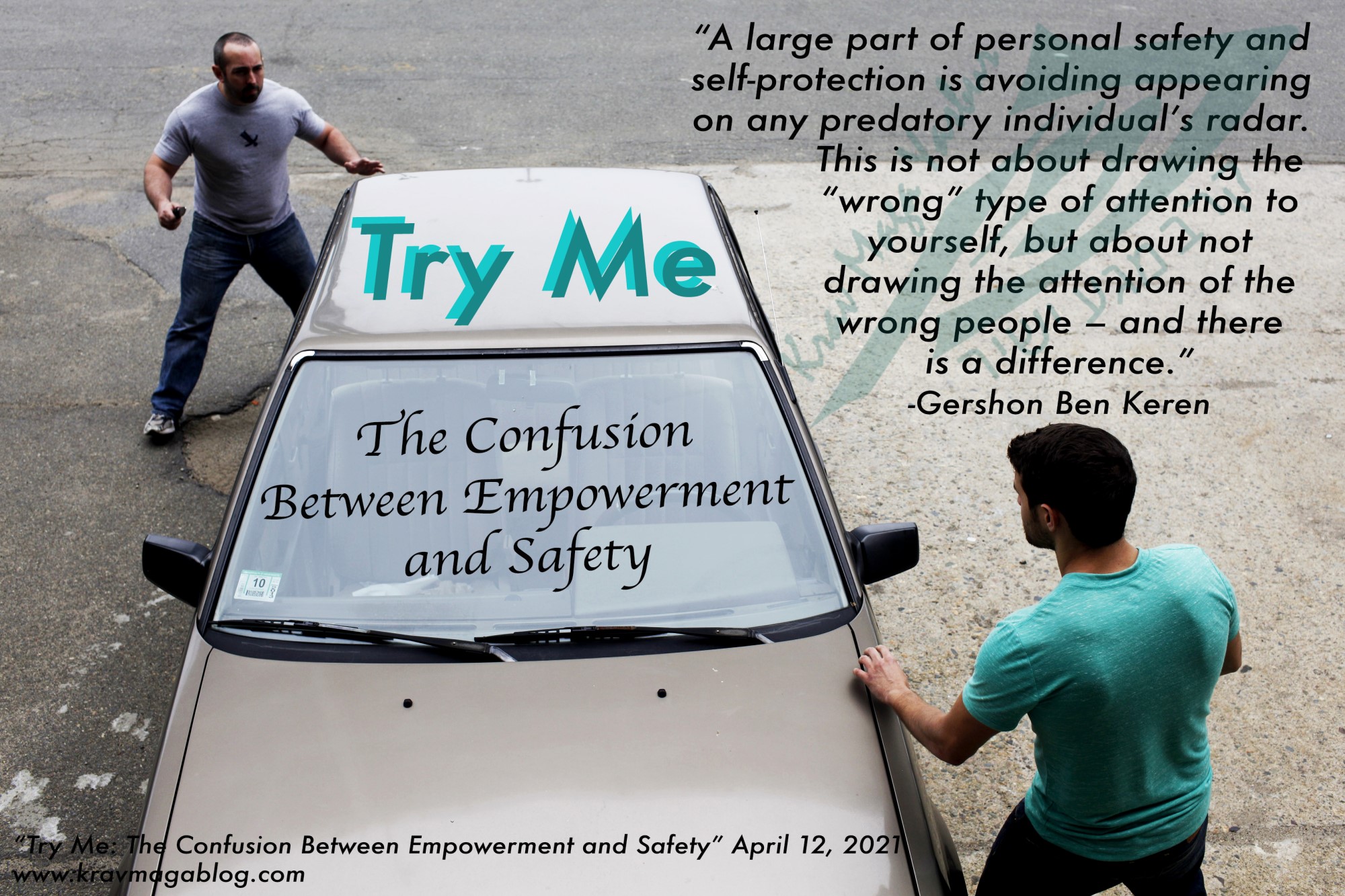Author: Gershon Ben Keren

I recently saw a t-shirt/top, aimed at women, that had emblazoned on it, “Want to See My Pepper Spray?” I’m sure the purpose/intention – other than to sell clothing – was that this was tied to a notion of empowerment, and this is where there is a great deal of confusion between empowerment and safety. Empowerment should not involve publicly drawing lines in the sand that people may choose to challenge; this is the opposite of empowerment. I am a great believer in empowering people, however we have to be clear about what we are empowering people for, and to do. From a personal safety/self-protection point of view, that may involve empowering a person (male or female) to have the confidence to deal with and exit a socially awkward situation, rather than telling them they must, always “stand their ground”. Having worked in security for many years, and seen/experienced a number of violent encounters, disengagement came to be my primary survival strategy, when not performing roles that required enforcement. In my experience, drawing lines in the sand which require other people to respect them, has almost always escalated an incident – the only times it hasn’t was when the individual(s) I was dealing with wasn’t particularly motivated. In this article I want to look at the issues with clothing bearing text, such as, “Krav Maga – Touch Me and Your First Lesson is Free” etc., and why the “empowerment” that wearing such clothing is intended to achieve, instead compromises the wearer’s safety.
A large part of personal safety and self-protection is avoiding appearing on any predatory individual’s radar. This is not about drawing the “wrong” type of attention to yourself, but about not drawing the attention of the wrong people – and there is a difference. There are still those in the self-defense industry who will tell women not to dress in short skirts, low-cut tops, etc because this draws the wrong type of attention from men, and puts them at risk of assault etc. There is absolutely no credible research or evidence to support this point of view/opinion. In terms of personal safety/self-protection we want to avoid being noticed by the “wrong” people i.e., those who are motivated to cause us harm, and put us at risk etc. They may look at a woman in a short dress, low top (I apologize for the use of this stereotype) etc. and see someone who is confident in the way that they dress and present themselves, and therefore someone to avoid attempting to victimize. At first glance, it would seem that a top with the line on it, “Want to See My Pepper Spray?”, portrays confidence, but it suggests quite the opposite i.e., if the fact needs to be advertised and broadcast, as a “challenge” then this denotes insecurity and vulnerability etc. We may choose to wear an item of clothing as a statement, that promotes a certain idea of empowerment to us, and at the same time might well send a different message, and be interpreted differently by a certain audience. If we understand that rape/sexual assault is primarily about power, control and anger, rather than sex, then we can see how somebody wearing such an item of clothing may attract the attention of a sexual predator e.g., they have a target who wants to appear to be confident and self-assured, but may in fact be attempting to disguise/hide a vulnerability etc. The message we want to send out, and the one that is received by others is not always the same.
Sometimes, it is worth changing context to understand how our messaging might be “off” or “misinterpreted”. If you were to walk into a rough neighborhood, which has a reputation for violence and gang-related activity, would you be more confident in avoiding being victimized if you were wearing a plain t-shirt or one that said, “Krav Maga – Touch Me and Your First Lesson is Free”? I would want to hope that I could pass through that locale unnoticed and not draw any attention to myself. When I used to carry out surveillance work, I never wore clothing that had words on it, as this is one of the quickest ways to draw attention to yourself; people will naturally want to read what’s written on your clothing, whatever the words say. Now those in the neighborhood, are not only having their attention drawn to what’s written on your clothing, but are being told that if they touch you, they’ll get hurt doing so etc. People who need to make such statements about themselves are by-and-large relying on the fact that they will never come into contact with a motivated offender who is prepared to take them up on their offer/challenge e.g., it’s a good t-shirt to wear when you’re shopping at Wholefoods, etc. However, this is not how we should be thinking about personal safety. If there is something that puts us at risk, that we can easily change then we should do this, rather than start making exceptions for ourselves, as it will be during one of these times/exceptions that our path happens to intersect with a truly motivated offender.
We all have an image we want to project of ourselves, and a narrative that we tell ourselves etc. As social creatures we all want to be seen, and interacted with, in a certain way. But when it comes to personal safety we shouldn’t look to explicitly insist and demonstrate that we are capable of defending ourselves through implicit challenges. This drawing of attention to ourselves creates a vulnerability, where there may have been no need for one.